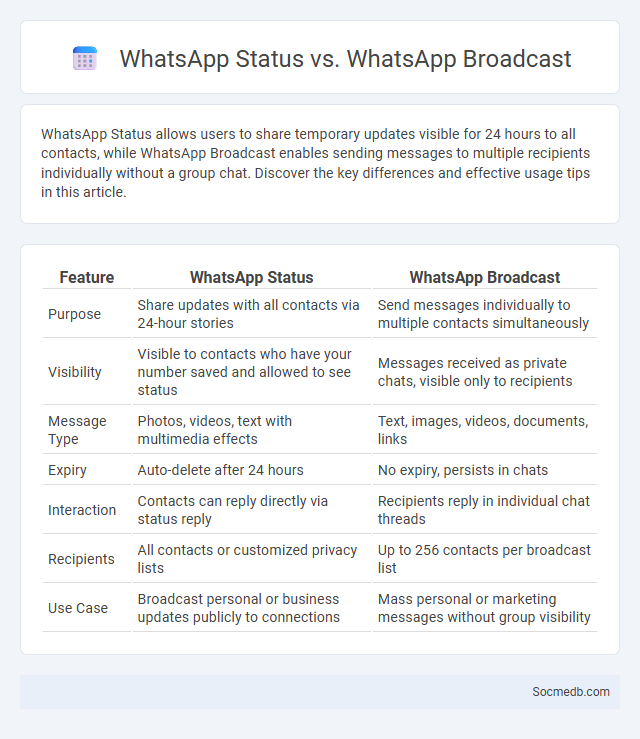
Photo illustration: WhatsApp Status vs WhatsApp Broadcast
WhatsApp Status allows users to share temporary updates visible for 24 hours to all contacts, while WhatsApp Broadcast enables sending messages to multiple recipients individually without a group chat. Discover the key differences and effective usage tips in this article.
Table of Comparison
| Feature | WhatsApp Status | WhatsApp Broadcast |
|---|---|---|
| Purpose | Share updates with all contacts via 24-hour stories | Send messages individually to multiple contacts simultaneously |
| Visibility | Visible to contacts who have your number saved and allowed to see status | Messages received as private chats, visible only to recipients |
| Message Type | Photos, videos, text with multimedia effects | Text, images, videos, documents, links |
| Expiry | Auto-delete after 24 hours | No expiry, persists in chats |
| Interaction | Contacts can reply directly via status reply | Recipients reply in individual chat threads |
| Recipients | All contacts or customized privacy lists | Up to 256 contacts per broadcast list |
| Use Case | Broadcast personal or business updates publicly to connections | Mass personal or marketing messages without group visibility |
Understanding WhatsApp Status: A Brief Overview
WhatsApp Status allows users to share text, photos, videos, and GIFs with their contacts for 24 hours, offering a dynamic way to communicate beyond traditional messaging. This feature provides privacy controls enabling users to select who can view their updates, enhancing user control over shared content. Over 500 million users engage with WhatsApp Status daily, making it a significant platform for personal expression and brand promotion.
What Is WhatsApp Broadcast? Key Features Explained
WhatsApp Broadcast allows you to send messages to multiple contacts simultaneously without creating a group, maintaining individual privacy and direct communication. Key features include message delivery to up to 256 contacts at once, no visible recipient list, and ease of sharing updates, promotions, or announcements efficiently. Your broadcast list ensures personalized outreach while saving time and enhancing engagement on social media platforms.
Defining WhatsApp Status Update: How It Works
WhatsApp Status Update enables you to share photos, videos, and text with your contacts for 24 hours, providing a dynamic way to express moments. Each status is encrypted end-to-end, ensuring privacy and security while allowing selective visibility through customizable privacy settings. Your contacts can view and respond to your status, making it an interactive feature that enhances social connection in real-time.
Comparing WhatsApp Status and Broadcast: Core Differences
WhatsApp Status allows users to share photos, videos, and text updates visible to contacts for 24 hours, emphasizing ephemeral, story-like interactions. Broadcast lists enable sending personalized messages to multiple recipients simultaneously without creating group chats, maintaining privacy while facilitating direct communication. Status updates foster public sharing, whereas Broadcast targets selective individual outreach, reflecting distinct communication objectives on the WhatsApp platform.
Pros and Cons of Using WhatsApp Status
WhatsApp Status allows you to share photos, videos, and text updates with your contacts, enhancing personal expression and real-time communication. However, frequent updates may expose your privacy and consume significant mobile data, impacting your digital security and budget. Balancing interaction benefits with potential risks ensures a mindful use of WhatsApp Status in your social media strategy.
Advantages and Limitations of WhatsApp Broadcast
WhatsApp Broadcast allows users to send messages to multiple contacts simultaneously without creating a group, ensuring personalized communication and preserving individual privacy. Its advantages include efficient information dissemination, high message open rates, and cost-effectiveness for businesses seeking direct customer engagement. Limitations involve a cap of 256 contacts per broadcast list, lack of real-time interaction, and potential issues with message delivery if recipients have not saved the sender's number.
Best Use Cases: Status vs Broadcast vs Status Update
Choosing the best use case for social media depends on your communication goals: Status updates are ideal for sharing brief, personal moments or current feelings with your close network, maintaining an organic connection. Broadcasts serve to disseminate important announcements or promotional content to a wider audience efficiently, maximizing reach and engagement. Understanding these distinctions helps you tailor your approach, ensuring your message resonates effectively with your intended followers.
Privacy Considerations for WhatsApp Status and Broadcast
WhatsApp Status and Broadcast features require users to be mindful of privacy settings to control who can view shared updates and messages effectively. Users should customize their privacy preferences to limit exposure only to trusted contacts, avoiding unintended sharing with unknown individuals or large groups. Understanding and regularly reviewing these privacy controls helps safeguard personal information and maintain secure communication within WhatsApp's platform.
Engagement Tips: Maximizing Impact on WhatsApp
Boost your WhatsApp engagement by creating personalized messages that resonate with your audience's interests and needs. Utilize multimedia features like images, videos, and voice notes to make interactions more dynamic and memorable. Encourage direct conversations by posing questions and responding promptly, enhancing Your connection and fostering meaningful relationships.
Which is Better: WhatsApp Status, Broadcast, or Status Update?
WhatsApp Broadcast allows targeted messaging to multiple recipients without revealing the list, making it ideal for personalized communication and business outreach. WhatsApp Status offers a more visual, ephemeral way to share updates, suitable for storytelling and engaging a broad audience with photos and videos available for 24 hours. For direct, one-to-many messages without audience interaction, Broadcast is better, while Status is preferable for social sharing and engagement.
 socmedb.com
socmedb.com